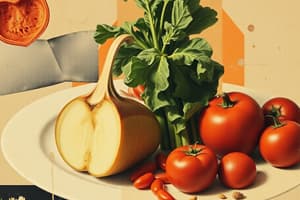Podcast
Questions and Answers
Gelatin is primarily used to thicken and set savory dishes like aspic.
Gelatin is primarily used to thicken and set savory dishes like aspic.
True (A)
Understanding the science of cooking does not help in troubleshooting issues in the kitchen.
Understanding the science of cooking does not help in troubleshooting issues in the kitchen.
False (B)
Precise temperature control is not important for processes like Maillard reactions and caramelization.
Precise temperature control is not important for processes like Maillard reactions and caramelization.
False (B)
Cutting food into inconsistent sizes may lead to uneven cooking.
Cutting food into inconsistent sizes may lead to uneven cooking.
Scientific knowledge in cooking limits creativity and experimentation.
Scientific knowledge in cooking limits creativity and experimentation.
The Maillard reaction occurs at low temperatures and requires sugar and amino acids.
The Maillard reaction occurs at low temperatures and requires sugar and amino acids.
Caramelization results in a color change of sugar from white to dark brown.
Caramelization results in a color change of sugar from white to dark brown.
Emulsifiers help oil and water mix by having separate properties for hydrophilic and lipophilic interactions.
Emulsifiers help oil and water mix by having separate properties for hydrophilic and lipophilic interactions.
The Maillard reaction is responsible for the crispy texture of grilled meats.
The Maillard reaction is responsible for the crispy texture of grilled meats.
Gelatin is derived from carbohydrates and forms a liquid structure when cooled.
Gelatin is derived from carbohydrates and forms a liquid structure when cooled.
Caramelization is primarily used in savory dishes to enhance bitterness.
Caramelization is primarily used in savory dishes to enhance bitterness.
Emulsification is the process of combining two immiscible liquids into a stable mixture.
Emulsification is the process of combining two immiscible liquids into a stable mixture.
Maillard reactions can only occur in sweet dishes, providing no useful flavor in savory foods.
Maillard reactions can only occur in sweet dishes, providing no useful flavor in savory foods.
Flashcards
Maillard Reaction
Maillard Reaction
Chemical reaction between amino acids and sugars at high temperatures, creating new flavor compounds.
Caramelization
Caramelization
Chemical breakdown of sugar when heated, changing color and creating complex flavors.
Emulsification
Emulsification
Mixing oil and water using emulsifiers, creating stable mixtures.
Emulsifier
Emulsifier
Signup and view all the flashcards
Gelation
Gelation
Signup and view all the flashcards
Gelatin
Gelatin
Signup and view all the flashcards
Culinary Science
Culinary Science
Signup and view all the flashcards
Predicting Outcomes
Predicting Outcomes
Signup and view all the flashcards
Temperature Control
Temperature Control
Signup and view all the flashcards
Maillard Reactions
Maillard Reactions
Signup and view all the flashcards
Caramelization
Caramelization
Signup and view all the flashcards
Mixing Techniques
Mixing Techniques
Signup and view all the flashcards
Emulsions
Emulsions
Signup and view all the flashcards
Cutting consistency
Cutting consistency
Signup and view all the flashcards
Gelatin Use
Gelatin Use
Signup and view all the flashcards
Culinary Mastery
Culinary Mastery
Signup and view all the flashcards
Study Notes
The Science of Cooking
- Cooking is more than just an art; it's a science. Reactions like the Maillard reaction, caramelization, emulsification, and gelation impact flavor and texture.
Maillard Reaction
- A chemical reaction between amino acids and sugars at high temperatures.
- Creates hundreds of new flavor compounds.
- Responsible for rich, savory flavors in roasted meats, browned bread, and toasted nuts.
- Creates an appealing brown crust on grilled meats and baked goods.
Caramelization
- Sugars decompose when heated.
- Series of chemical changes.
- Changes color from white to amber to dark brown.
- Creates complex flavors and aromas.
- Used to create sweetness and rich color in desserts, sauces, and savory dishes.
Emulsification
- Oil and water naturally don't mix.
- Emulsifiers have hydrophilic (water-loving) and lipophilic (fat-loving) parts.
- Emulsifiers allow oil and water to mix, stabilizing the mixture.
- Used in mayonnaise, hollandaise sauce, and salad dressings.
Gelation
- Gelatin, a protein derived from collagen, forms a three-dimensional network when it cools.
- The network traps water molecules.
- Creates a solid, jiggly texture.
- Used in thickening and setting sauces, desserts, and savory dishes (e.g., aspic).
Applying Culinary Science
- Understanding how ingredients react to heat, moisture, and other factors can improve cooking techniques.
- Scientific knowledge allows experimentation with different ingredients and techniques to create unique dishes.
- Knowing the science behind cooking allows for predicting outcomes and troubleshooting issues more effectively.
Mastering Cooking Techniques
- Temperature Control: Crucial for Maillard reactions, caramelization, and other cooking processes.
- Timing: Precise timing ensures proper reactions and desired results at different temperatures.
- Mixing Techniques: Proper mixing creates emulsions, incorporates air, and achieves desired textures.
- Cutting and Slicing: Consistent sizes ensure even cooking and maximize surface area for reactions.
Studying That Suits You
Use AI to generate personalized quizzes and flashcards to suit your learning preferences.




